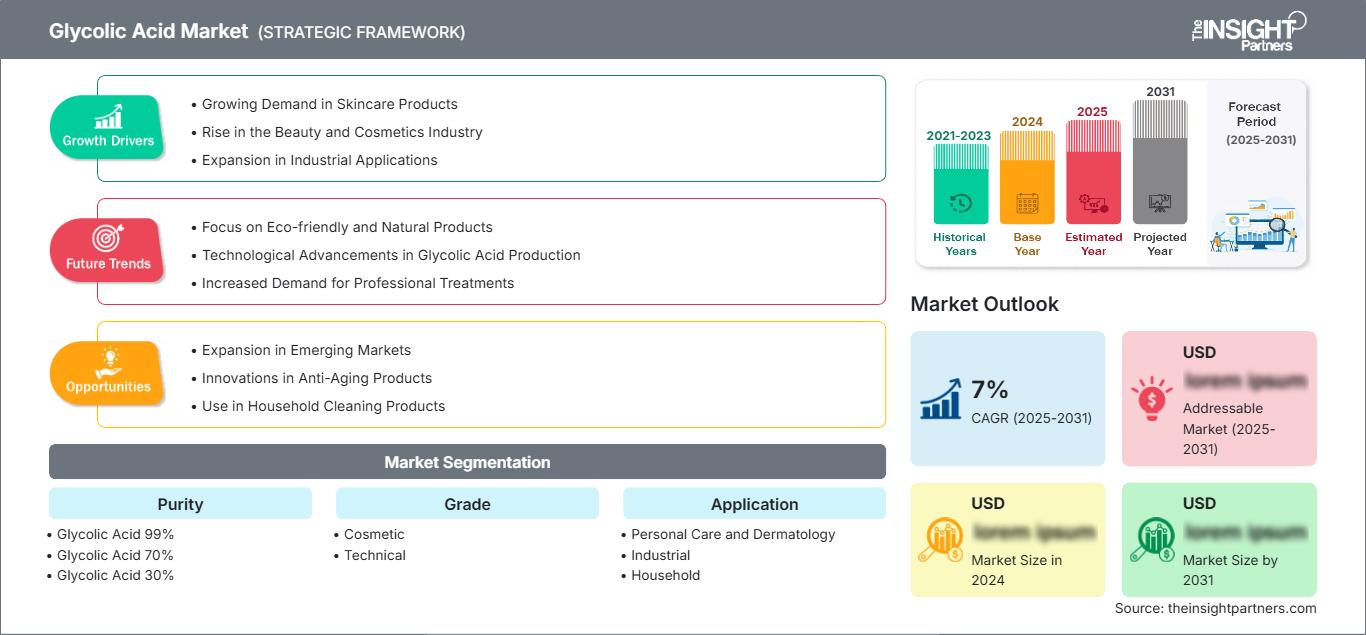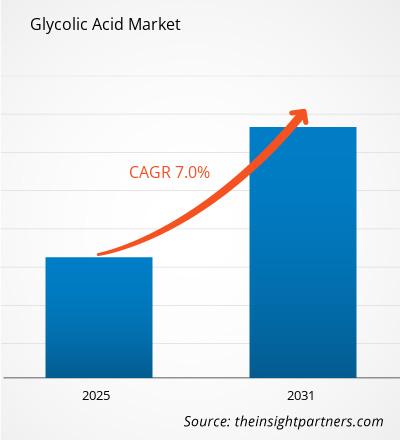Si prevede che il mercato dell'acido glicolico registrerà un CAGR del 7% dal 2025 al 2031, con una dimensione del mercato in espansione da XX milioni di dollari nel 2024 a XX milioni di dollari entro il 2031.
Il rapporto è segmentato per purezza (acido glicolico 99%, acido glicolico 70%, acido glicolico 30% e altri). Il rapporto presenta inoltre un'analisi basata sul grado (cosmetico e tecnico). In base all'applicazione, il rapporto è segmentato in (cura della persona e dermatologia, industriale, domestico e altri). L'analisi globale è ulteriormente suddivisa a livello regionale e per i principali paesi. Il rapporto offre il valore in USD per l'analisi e i segmenti sopra indicati.
Scopo del rapporto
Il rapporto sul mercato dell'acido glicolico di The Insight Partners mira a descrivere il panorama attuale e la crescita futura, i principali fattori trainanti, le sfide e le opportunità. Ciò fornirà spunti a vari stakeholder aziendali, come:
- Fornitori/produttori di tecnologia: per comprendere le dinamiche di mercato in evoluzione e conoscere le potenziali opportunità di crescita, consentendo loro di prendere decisioni strategiche informate.
- Investitori: per condurre un'analisi completa delle tendenze in merito al tasso di crescita del mercato, alle proiezioni finanziarie del mercato e alle opportunità esistenti lungo la catena del valore.
- Organismi di regolamentazione: per regolamentare le politiche e le attività di controllo nel mercato con l'obiettivo di ridurre al minimo gli abusi, preservare la fiducia degli investitori e sostenere l'integrità e la stabilità del mercato.
Segmentazione del mercato dell'acido glicolico Purezza
- Acido glicolico 99%
- Acido glicolico 70%
- Acido glicolico 30%
Grado
- Cosmetico
- Tecnico
Applicazione
- Cura della persona e dermatologia
- Industriale
- Domestico
Geografia
- Nord America
- Europa
- Asia-Pacifico
- America meridionale e centrale
- Medio Oriente e Africa
Potrai personalizzare gratuitamente qualsiasi rapporto, comprese parti di questo rapporto, o analisi a livello di paese, pacchetto dati Excel, oltre a usufruire di grandi offerte e sconti per start-up e università
Mercato dell'acido glicolico: Approfondimenti strategici

-
Ottieni le principali tendenze chiave del mercato di questo rapporto.Questo campione GRATUITO includerà l'analisi dei dati, che vanno dalle tendenze di mercato alle stime e alle previsioni.
Fattori di crescita del mercato dell'acido glicolico
- Crescente domanda di prodotti per la cura della pelle: l'acido glicolico è ampiamente utilizzato nei prodotti per la cura della pelle, inclusi detergenti per il viso, sieri e trattamenti anti-età, grazie alle sue proprietà esfolianti e ringiovanenti. Con la crescente attenzione dei consumatori alle soluzioni per la cura della pelle e anti-età, la domanda di acido glicolico è in aumento. La sua popolarità nel settore cosmetico, in particolare nei trattamenti per l'acne e la pigmentazione, è un fattore chiave per la crescita del mercato dell'acido glicolico.
- Ascesa nel settore della bellezza e dei cosmetici: il settore globale della bellezza e dei cosmetici sta vivendo una forte crescita e l'acido glicolico svolge un ruolo cruciale in molti trattamenti di bellezza. Viene utilizzato in peeling chimici, creme idratanti e trattamenti per l'acne grazie alla sua capacità di migliorare la consistenza e l'aspetto della pelle. Con l'aumento della domanda di prodotti per la cura della pelle efficaci e di alta qualità, il ruolo dell'acido glicolico nel settore della bellezza si rafforza, stimolando l'espansione del mercato.
- Espansione nelle applicazioni industriali: l'acido glicolico è utilizzato in una varietà di applicazioni industriali come la finitura tessile, la pulizia dei metalli e come intermedio chimico nella produzione di altri prodotti chimici. La sua domanda è in aumento poiché le industrie cercano soluzioni efficienti ed economiche per la produzione e la lavorazione. La crescita dell'uso industriale contribuisce alla domanda complessiva di acido glicolico, rafforzandone ulteriormente la presenza sul mercato.
Tendenze future del mercato dell'acido glicolico
- Focus su prodotti ecologici e naturali: il crescente interesse dei consumatori per prodotti per la cura della pelle ecologici e naturali è una tendenza significativa che sta plasmando il mercato dell'acido glicolico. I produttori si stanno concentrando sull'approvvigionamento di acido glicolico da fonti rinnovabili e naturali come canna da zucchero e barbabietole. Questo passaggio verso ingredienti sostenibili e biologici continuerà a influenzare il mercato, offrendo opportunità di crescita per l'acido glicolico derivato da pratiche eco-consapevoli.
- Progressi tecnologici nella produzione di acido glicolico: lo sviluppo di nuovi metodi più efficienti per la produzione di acido glicolico è una tendenza chiave. Progressi come la produzione a base biologica e i miglioramenti nei processi di fermentazione aumenteranno l'efficienza produttiva, ridurranno i costi e renderanno l'acido glicolico più ampiamente disponibile. Si prevede che queste innovazioni tecnologiche daranno impulso al mercato dell'acido glicolico e soddisferanno la crescente domanda di prodotti per la cura della pelle da parte dei consumatori.
- Maggiore domanda di trattamenti professionali: c'è una crescente tendenza verso i peeling chimici professionali con acido glicolico nelle cliniche dermatologiche e nelle spa. Questi trattamenti offrono benefici come una pelle più liscia, segni di invecchiamento ridotti e una texture cutanea migliore. Con l'aumento della domanda di acido glicolico nei trattamenti cosmetici e la ricerca di soluzioni professionali per la cura della pelle, la domanda di acido glicolico continuerà ad aumentare, trainando la crescita del mercato.
Opportunità di mercato per l'acido glicolico
- Espansione nei mercati emergenti: i mercati emergenti, in particolare nell'area Asia-Pacifico e in America Latina, offrono significative opportunità di crescita per l'acido glicolico. La crescente classe media, l'aumento del reddito disponibile e la crescente domanda di prodotti per la cura della pelle e cosmetici in queste regioni offrono un vasto mercato inesplorato. L'espansione dei canali di distribuzione e la focalizzazione su queste economie in via di sviluppo offriranno significative opportunità di crescita per i produttori di acido glicolico.
- Innovazioni nei prodotti anti-età: la crescente domanda di prodotti anti-età per la cura della pelle offre un'opportunità per le formulazioni a base di acido glicolico. Poiché l'acido glicolico è noto per le sue proprietà esfolianti e ringiovanenti, i produttori possono sviluppare soluzioni anti-età innovative che ne sfruttino i benefici. Questo segmento in crescita nel settore della bellezza e della cura della pelle offre un'opportunità promettente per l'espansione del mercato dell'acido glicolico.
- Utilizzo nei prodotti per la pulizia domestica: l'acido glicolico sta guadagnando popolarità anche nei prodotti per la pulizia domestica grazie alla sua efficacia nella rimozione di macchie, residui di sapone e depositi minerali. Con la crescente domanda di soluzioni detergenti ecologiche ed efficaci, l'uso dell'acido glicolico nel mercato dei prodotti per la pulizia domestica e industriale rappresenta un'opportunità redditizia per la sua applicazione, diversificandone la portata di mercato.
Mercato dell'acido glicolico
Le tendenze regionali e i fattori che influenzano il mercato dell'acido glicolico durante il periodo di previsione sono stati ampiamente spiegati dagli analisti di The Insight Partners. Questa sezione illustra anche i segmenti e la geografia del mercato dell'acido glicolico in Nord America, Europa, Asia-Pacifico, Medio Oriente e Africa, America meridionale e centrale.
Ambito del rapporto di mercato dell'acido glicolico>
| Attributo del rapporto | Dettagli |
|---|---|
| Dimensioni del mercato in 2024 | US$ XX million |
| Dimensioni del mercato per 2031 | US$ XX Million |
| CAGR globale (2025 - 2031) | 7% |
| Dati storici | 2021-2023 |
| Periodo di previsione | 2025-2031 |
| Segmenti coperti |
By Purezza
|
| Regioni e paesi coperti |
Nord America
|
| Leader di mercato e profili aziendali chiave |
|
Densità degli attori del mercato dell'acido glicolico: comprendere il suo impatto sulle dinamiche aziendali
Il mercato dell'acido glicolico è in rapida crescita, trainato dalla crescente domanda da parte degli utenti finali, dovuta a fattori quali l'evoluzione delle preferenze dei consumatori, i progressi tecnologici e una maggiore consapevolezza dei benefici del prodotto. Con l'aumento della domanda, le aziende stanno ampliando la propria offerta, innovando per soddisfare le esigenze dei consumatori e sfruttando le tendenze emergenti, alimentando ulteriormente la crescita del mercato.

- Ottieni il Mercato dell'acido glicolico Panoramica dei principali attori chiave
Punti di forza
- Copertura completa: il rapporto copre in modo completo l'analisi di prodotti, servizi, tipologie e utenti finali del mercato dell'acido glicolico, fornendo un panorama olistico.
- Analisi di esperti: il rapporto è compilato sulla base della conoscenza approfondita di esperti e analisti del settore.
- Informazioni aggiornate: il rapporto garantisce rilevanza aziendale grazie alla sua copertura di informazioni recenti e tendenze dei dati.
- Opzioni di personalizzazione: questo rapporto può essere personalizzato per soddisfare le esigenze specifiche del cliente e adattarsi in modo appropriato alle strategie aziendali.
Il rapporto di ricerca sul mercato dell'acido glicolico può, quindi, aiutare a guidare il percorso di decodificazione e comprensione dello scenario del settore e delle prospettive di crescita. Sebbene possano esserci alcune preoccupazioni valide, i vantaggi complessivi di questo rapporto tendono a superare gli svantaggi.
- Analisi storica (2 anni), anno base, previsione (7 anni) con CAGR
- Analisi PEST e SWOT
- Valore/volume delle dimensioni del mercato - Globale, Regionale, Nazionale
- Industria e panorama competitivo
- Set di dati Excel
Report recenti
Rapporti correlati
Testimonianze
Motivo dell'acquisto
- Processo decisionale informato
- Comprensione delle dinamiche di mercato
- Analisi competitiva
- Analisi dei clienti
- Previsioni di mercato
- Mitigazione del rischio
- Pianificazione strategica
- Giustificazione degli investimenti
- Identificazione dei mercati emergenti
- Miglioramento delle strategie di marketing
- Aumento dell'efficienza operativa
- Allineamento alle tendenze normative






















 Ottieni un campione gratuito per - Mercato dell'acido glicolico
Ottieni un campione gratuito per - Mercato dell'acido glicolico